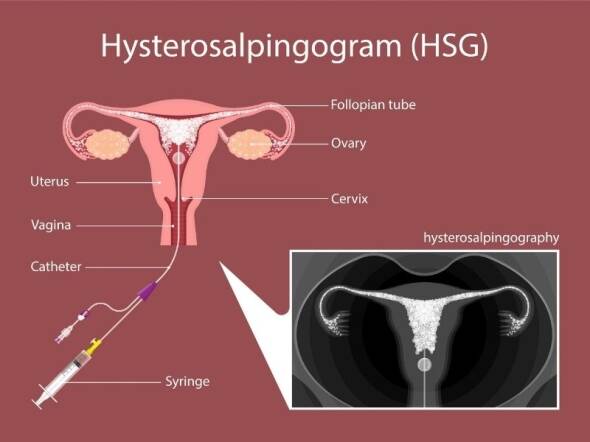A hysterosalpingogram or HSG test lets your doctor examine the inside walls of your uterus and fallopian tubes. This minor procedure is designed to provide information about the shape and contour of the endometrial cavity (uterus) or to document the presence of endometrial polyps, leiomyomata (fibroids), or scarring. In addition, the procedure will determine whether the fallopian tubes are patent (open).
Having a blocked fallopian tube or a growth in your uterus can reduce your chances of pregnancy. If your fallopian tubes are blocked, the sperm can’t reach the egg. A hysterosalpingogram or HSG test uses x-rays and a special dye to detect scar tissue, polyps, fibroids, and other growths that may be blocking your tubes or preventing a fertilized egg from implanting properly in your uterus.
Another test, called a sonohysterogram, uses ultrasound and a special solution to detect abnormalities inside the uterus. However, the sonohysterogram cannot be used to detect blocked fallopian tubes. An HSG is routinely performed as part of an infertility workup.
What should I expect during an HSG Test?
- An HSG test is usually done in a radiology lab and takes between 10 and 30 minutes.
- Your doctor will insert a speculum into your vagina (like when you have a Pap smear), and then place a thin plastic tube inside your cervix that will lead to your uterus and fallopian tubes. A special dye will be injected through the plastic tube. The dye should fill your uterus and fallopian tubes and spill out of each fallopian tube.
- Next, x-rays will be taken, and your doctor can evaluate your uterus and fallopian tubes. Learn more about your HSG procedure.
You can watch a video of the procedure over at the Mayo Clinic.
Surprising Ways Yoga Boosts Your Overall Health
Learn how yoga supports your physical health, mental clarity, and overall well-being!
Is the HSG procedure painful?
Many women feel some cramping, especially when the dye is injected. Women who have a blocked fallopian tube may feel intense pain. Over-the-counter pain medicines such as ibuprofen can help relieve this pain or discomfort.
Speak to your doctor about taking pain medication 30 to 60 minutes before the procedure to prevent or reduce pain during the test.
Is it OK to drive home by myself after an HSG test?
Many women have no pain after the HSG, but you may feel crampy or achy after the procedure, so it’s a good idea to have someone else drive you home.
What are the risks or possible side effects of a hysterosalpingogram?
The risks of the HSG include:
- Pain or discomfort
- Infection
- Vaginal spotting or bleeding
Contact your doctor if you develop:
- A fever or continue to feel pain for more than a few days
- Heavy bleeding
- Lower abdominal pain
- Foul-smelling discharge
- Temperature over 100º F
IMPORTANT NOTE:
On rare occasions, a woman may have an allergy to the iodine contrast used in an HSG. Patients with documented allergies to iodine, intravenous contrast dyes, or shellfish should make that know to the physician prior to the procedure.
When is the best time during my cycle to schedule the HSG test?
The test should be scheduled after your period ends, but before you expect to ovulate, usually between days 6 and 10 of your menstrual cycle. To figure out the days of your cycle, count day 1 as the day your period begins.
How should I prepare for a hysterosalpingogram?
Antibiotics are given prophylactically to prevent infection. It should be taken the day prior, the day of, and the day after the HSG.
Your referring physician should prescribe Doxycyline 100mg tablets (antibiotic), to be taken twice daily for 3 days. If you are allergic to doxycycline then Zithromax (Z-Pak) can be used as an alternative.
Scheduling an HSG Test
We recommend that you call on day 1 of your menses to schedule your HSG. Please note that HSGs are not performed at all offices, so you may have to visit a different office location for the procedure. When you schedule the appointment, our staff will provide you with all of the details you will need for the day of your procedure. Typically they are scheduled Monday through Friday between 7:00 AM – 4:00 PM. When scheduling an HSG, you will be asked to provide your name, date of birth, social security number, and insurance information.
HSG Referral and Insurance Authorization Information
Contact your insurance provider to determine if you have coverage for the test and whether they require a referral and/or a prior authorization. You can provide them with the following codes:
- HSG CPT codes: 74740, 58340 (procedure code)
- HSG Dx code: V26.21 (diagnosis code)
Please note: It is the responsibility of your referring physician to obtain a referral or prior authorization from your insurance provider.

